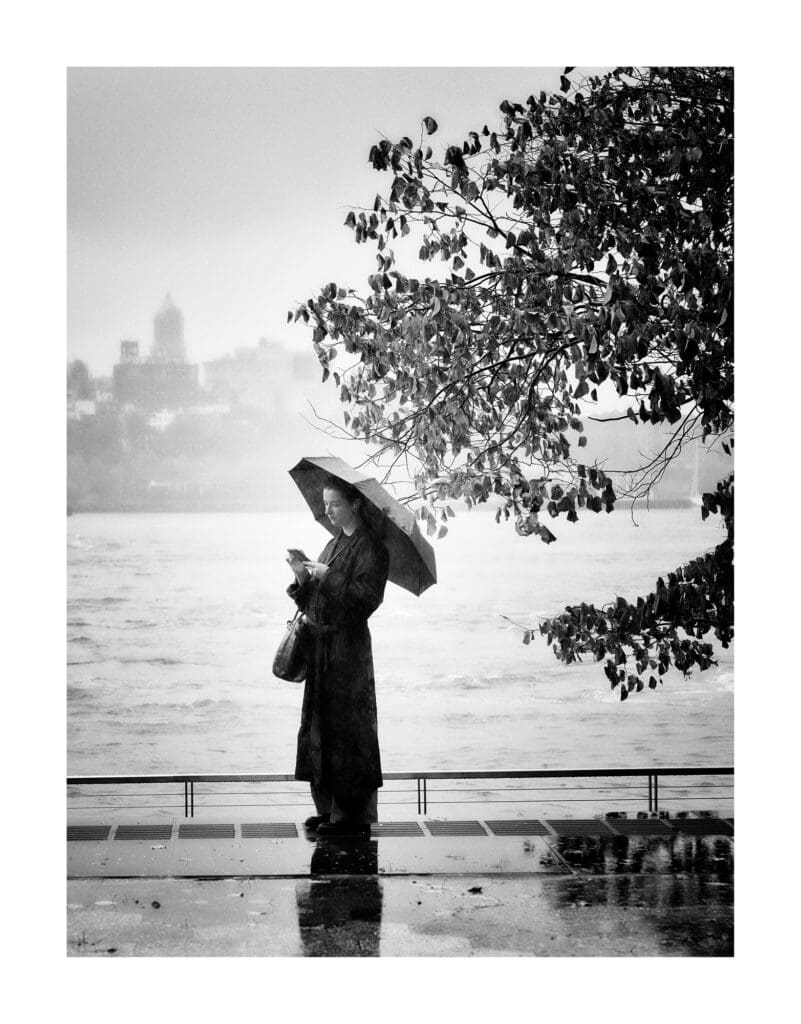For once, I do not write myself, but republish an article on one of my photos in the Digital Companion, Edition December 2024 by W. Scott Olsen. As this is on a paid site, I asked the editor for the possibility to re-publish the article here, which was kindly granted.
Reading Frames
“Autumn in New York” by Ulrich Jousten
By W. Scott Olsen

Let’s begin with, and stay with, the image.
A great many images hope for dynamic energy. Wildlife Images, sporting images, wedding images, candids of family and friends—a lot of photography tries to capture a kinetic sense of energy, which implies a narrative we appreciate as viewers.
There are, however, other schools of photography which celebrate the static. Still life photography is one of them. But perhaps the best-known apparently static image is the portrait.
Portraits, beginning with painting and drawing long before photography came along, have been a way to memorialize somebody, to give them a kind of permanence beyond the health or infirmity of the body. The portrait artist tries to capture something essential about a person’s character or soul in their expression and demeanor, and sometimes in their setting. Paintings of royals and other famous people have, for example, often had two layers of content-consideration. One is the portrayal of the person; the other is the artifacts and accouterments of the background, which often act as symbols of various measures of importance.
Most portrait photography is done in a studio. There is control over light and shadow. Expressions can be studied and modified. Wardrobe is an aesthetic choice for history. Everything about the image is a decision.
Yet there is also a whole genre of portraits that are serendipitous, unplanned, occasions of the moment. These come from a subset of street photography—the street portrait.
While there are always exceptions, in general the street portrait memorializes a person in situ. There have been no pre-arranged or thought-about constructions. The setting is not an intentional metaphor. But by whatever magic brings compositional elements suddenly together, a decisive moment occurs and an insight into character or the human condition is revealed.
Look like this image by Ulrich Jousten. The first time I saw this image, I was struck by a sense of peace, a sense of calmness, a sense of serenity and introspection, which I did not expect. I cannot tell you this woman’s name, or anything about her personality. I cannot tell you about her real mood or hopes. She is anonymous to me, and thus—and this is important—she rises to the level of metaphor.
Actually, that’s not right. The image, of which she is a part, rises to metaphor.
When you look at the image, there’s actually a lot going on. The weather is inclement. It’s raining—not the violent downpours of hurricane or thunderstorm, but certainly enough to warrant protection. The water in the river is not calm, so clearly there is wind associated with this storm. There is enough rain that the far shore is in mist, and the sidewalk closest to the lens is slick. The setting, in other words, is a difficult day.
The tree to the right in this image moves from lighter tones to darker tones, left to right, from clarity into mystery. It also has the shape, for lack of a better term, of a monster. There is a space that looks like an open jaw, a slot for the eyes, even a hint of a tongue. This tree/monster seems to be coming in from the right side of the image and about to consume the woman in the middle. The reflection and shadow on the sidewalk underneath the tree is a nice element that adds depth, contrasted with the monotone gray of the featureless sky upper left.
But the most striking part of this image, of course, is the woman in the middle. The day around her is windy and rainy and threatening, yet the umbrella rests on her shoulder in a casual and almost comfortable way. She wears a raincoat, but is not holding its lapels close as if the weather threatens. Instead, she is doing the most mundane of contemporary activities: checking something on her cell phone. She could be looking at an incoming call from a lover or friend. She could be looking at a grocery list. It doesn’t really matter. What matters is her expression, both on her face and in the way she stands.
So why do I have such a feeling of peace, looking at an image which includes storm and a monster? This woman, in the midst of storm, looks relaxed. Her expression is both alert and at ease. The expression on her face is neither joy nor sadness. It is not deeply contemplative either. It seems matter of fact. Yes, she thinks, perhaps I will buy some coffee on the way home.
The fact that this image is in black and white gives it the well-known appeal of timelessness. This is not so much the narrative of a particular woman on a particular day as it is a tableau, as it is a metaphor or a symbol for that moment in all our days when the storm around us, the chaos of our lives, is present but also manageable. We know peace because we know strife and threat.
The fact that the branches are connected visually to the umbrella adds a level of complication. Perhaps the monster is growing out of the shield. Perhaps it is about to consume it. These things don’t need to be resolved. There are so many counterpoints here: the elegant vertical line of the woman, the horizontal line of the grates in the pavement and of the river, the nicely placed horizon at the half-way mark in the vertical aspect, the formalism of the sidewalk and rail, the naturalism of the tree. They add to the tension of the image and deepen my appreciation for her apparent calm.
I’m aware my reaction to this image is, in large part, a projection of my own psychology and aesthetics. Then again, that’s how all of us respond to art. There is something here I recognize from my own life, not in situation but in context.
And I am reminded of the Zen Buddhist phrase: Before enlightenment; chop wood, carry water. After enlightenment; chop wood, carry water. I see the hope and optimism of the mundane here, in the midst of the difficult.
Thank you wholeheartedly, Scott, for this enlightening review. Very much appreciated!
